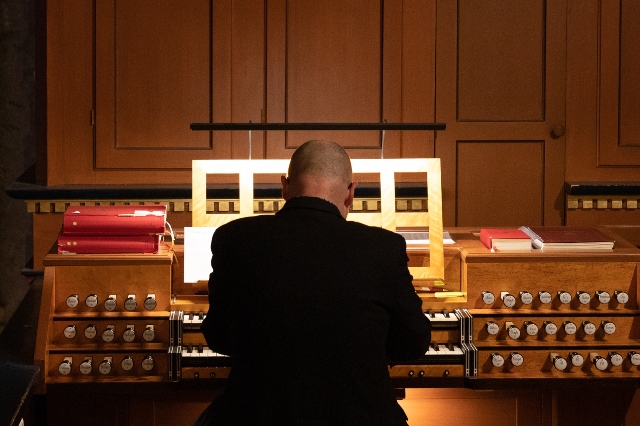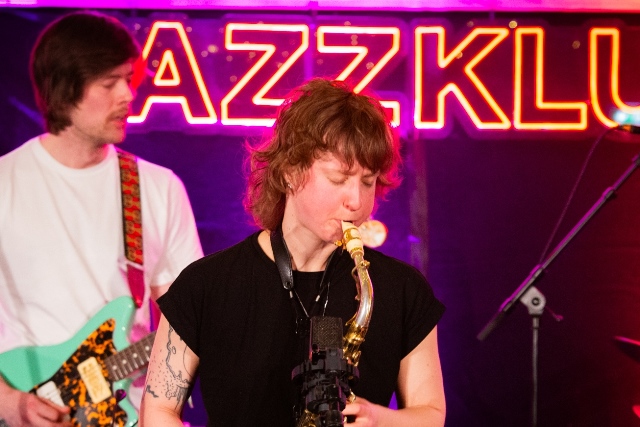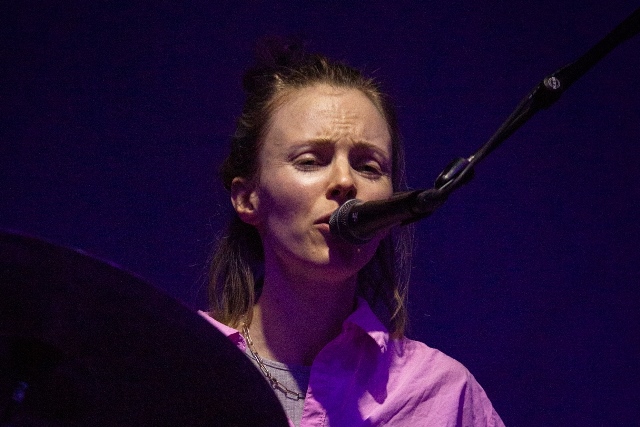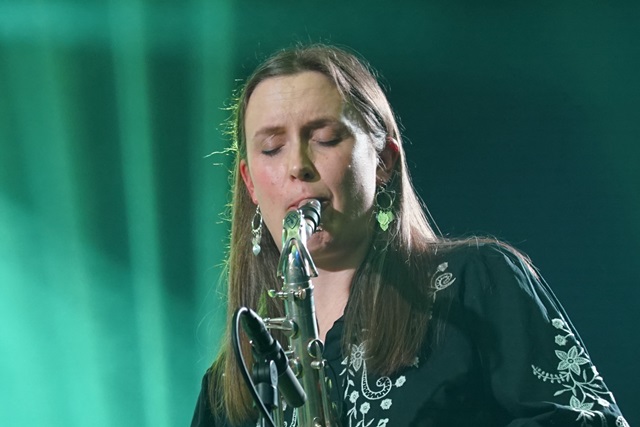Vossa Jazz 2024 review - Norwegian festival embraces William Parker’s spaciness, Karin Krog’s classicism and much more | reviews, news & interviews
Vossa Jazz 2024 review - Norwegian festival embraces William Parker’s spaciness, Karin Krog’s classicism and much more
Vossa Jazz 2024 review - Norwegian festival embraces William Parker’s spaciness, Karin Krog’s classicism and much more
Never mind the picture-postcard setting, the music is what matters

“The name of this group is Mayan Space Station.” In spite of the billing as The William Parker Trio, their bassist – coolly introducing himself as “William Parker, bass” – is firm about the designation under which the three musicians on stage are operating.
Mayan Space Station is also the title of a recent album. On the 2021 release, Parker was joined by drummer Gerald Cleaver and guitarist Ava Mendoza. All three are here, on stage in the basement of the Park Hotel in the lakeside village of Voss, to the east of Bergen. Getting here from Norway’s second city, the just-more than an hour train journey passes alongside snow-capped mountains, through tunnels and skirts glistening lakes. Picture-postcard Norway at its loveliest.
 Parker, Cleaver and Mendoza are playing the 51st edition of Vossa Jazz, a high-end, three-day annual festival initially established after it was noticed that Voss was often crowded with folks attracted by the skiing. What else would they want to do? See live jazz of course. (Pictured right, Karin Krog at Vossa Jazz 2024. Vossa Jazz/Anders Flatlandsmo)
Parker, Cleaver and Mendoza are playing the 51st edition of Vossa Jazz, a high-end, three-day annual festival initially established after it was noticed that Voss was often crowded with folks attracted by the skiing. What else would they want to do? See live jazz of course. (Pictured right, Karin Krog at Vossa Jazz 2024. Vossa Jazz/Anders Flatlandsmo)
The Mayan Space Station album became free-jazz bassist Parker’s first venture as part of an electric-guitar trio, an overdue foray considering he has been playing since the Seventies and recording since the Eighties. Cleaver and Parker have often worked together, and teaming up with Mendoza propels them into new territory. Parker’s past work with Peter Brötzmann, Cecil Taylor and many more did not point towards what’s on stage here. For established cross-genre guitarist Mendoza though, this is not fresh turf. Similarly, despite the musical reframing, Parker is, essentially, plugging into an on-going continuum: “Mayan Space Station” was the title of a track on his 1997 live album Sunrise In The Tone World.
 Unlike the recent album, this performance is not broken down into tracks. The three musicians come on stage, instantly dive in and maintain the musical pressure throughout one long-form piece. Afterwards, Mendoza, who has recorded it, checks and says they played for 59 minutes, 58 seconds. All the time, there is no let up. While there are quiet passages and diversions into solos, it’s a cohesive, ebbing, flowing whole where Mendoza’s shards of sound weave through Parker’s persistent, percussive, unyielding bass figures and Cleaver’s circularity. Hypnotic, bordering on psychedelic. When Parker picks up a double-reed wind instrument and begins blowing, it gets way spacier. (Pictured left, Sigbjørn Apeland at Vossa Jazz 2024. Vossa Jazz/Adne Dyrnesli)
Unlike the recent album, this performance is not broken down into tracks. The three musicians come on stage, instantly dive in and maintain the musical pressure throughout one long-form piece. Afterwards, Mendoza, who has recorded it, checks and says they played for 59 minutes, 58 seconds. All the time, there is no let up. While there are quiet passages and diversions into solos, it’s a cohesive, ebbing, flowing whole where Mendoza’s shards of sound weave through Parker’s persistent, percussive, unyielding bass figures and Cleaver’s circularity. Hypnotic, bordering on psychedelic. When Parker picks up a double-reed wind instrument and begins blowing, it gets way spacier. (Pictured left, Sigbjørn Apeland at Vossa Jazz 2024. Vossa Jazz/Adne Dyrnesli)
Of course, one live set does not define a festival – but the Mayan Space Station experience underlines Vossa Jazz’s yen to embrace the distinctive. There are connections too. Back in 1997, on the Sunrise In The Tone World album, alongside the foundational "Mayan Space Station" another cut was "Sunship for Dexter," dedicated to Dexter Gordon. And a further big name this year is Norway’s own Karin Krog who, in 1970, made the Some Other Spring Blues And Ballads with Gordon. In Voss, linking tendrils are never far.
 Krog plays the Park’s Vossasalen ballroom. Nothing from Some Other Spring… is performed, but during what is billed as by Karin Krog & The In Between Times, with Terje Gewelt (double bass) and Staffan William-Olsson (guitar), she digs deep – Krog has been performing since the mid 1950s, recording since 1963 and made her first album in 1964. She has interpreted standards, issued pop-inclined material, made challenging records with treatments of her vocals, embraced synthesisers with her musical and life partner John Surman. Musically, she has gone anywhere she has fancied. Here, the 14-song set found her stepping away from the challenging – though dizzying, chirruping effects on her voice were employed during the Surman-penned “Dream Dancing.” It began with a delicate interpretation of Rodgers and Hart’s 1930’s composition "My Romance" and ranged though warm readings of Joni Mitchell’s 1971 track “All I Want” and Stan Getz’s “Don't Get Scared.” A fantastic performance – with Surman on stage for four songs of the latter part of the set – and a privilege to see this giant of Norwegian culture. (Pictured right, Aurom at Vossa Jazz 2024. Vossa Jazz/Runhild Heggem)
Krog plays the Park’s Vossasalen ballroom. Nothing from Some Other Spring… is performed, but during what is billed as by Karin Krog & The In Between Times, with Terje Gewelt (double bass) and Staffan William-Olsson (guitar), she digs deep – Krog has been performing since the mid 1950s, recording since 1963 and made her first album in 1964. She has interpreted standards, issued pop-inclined material, made challenging records with treatments of her vocals, embraced synthesisers with her musical and life partner John Surman. Musically, she has gone anywhere she has fancied. Here, the 14-song set found her stepping away from the challenging – though dizzying, chirruping effects on her voice were employed during the Surman-penned “Dream Dancing.” It began with a delicate interpretation of Rodgers and Hart’s 1930’s composition "My Romance" and ranged though warm readings of Joni Mitchell’s 1971 track “All I Want” and Stan Getz’s “Don't Get Scared.” A fantastic performance – with Surman on stage for four songs of the latter part of the set – and a privilege to see this giant of Norwegian culture. (Pictured right, Aurom at Vossa Jazz 2024. Vossa Jazz/Runhild Heggem)
Away from the Park Hotel’s many stages in the Vangskyrkja – one of the few buildings not destroyed in April 1940’s German bombing of Voss – Sigbjørn Apeland sits behind the church’s organ fashioning waves of sound so powerful they compress the air. As the arpeggios of one crescendo fade, the next takes its place to aim even higher. In the same setting the female vocal trio Aurom, who focus on the unaccompanied kveding style of story song, are similarly impactful. Both performances are at home in this building, many times restored but first constructed in the 13th century. Sigbjørn Apeland and Aurom feel timeless.
 Up a hill from the church, ten-minutes’ walk away, is the Ole Bull Akademiet. It opened in 1977 as a school of folk music and dance. Bergen-resident violinist Bull (1810–1880) was pivotal to defining Norway’s traditional music and it took almost a century for a centre in his name to be founded. The school houses the Osasalen, named after the violinist Sigbjørn Osa who, in 1973, caused major media eyebrow-raising by performing with the Bergen band Saft – the first time a traditional Norwegian musician collaborated with a rock group. There was a precursor: in 1964, Vossa Jazz’s spectral presence Dexter Gordon played with traditional Norwegian musicians at the Molde festival. (Pictured left, Emmeluths Amoeba at Vossa Jazz 2024. Vossa Jazz/Runhild Heggem)
Up a hill from the church, ten-minutes’ walk away, is the Ole Bull Akademiet. It opened in 1977 as a school of folk music and dance. Bergen-resident violinist Bull (1810–1880) was pivotal to defining Norway’s traditional music and it took almost a century for a centre in his name to be founded. The school houses the Osasalen, named after the violinist Sigbjørn Osa who, in 1973, caused major media eyebrow-raising by performing with the Bergen band Saft – the first time a traditional Norwegian musician collaborated with a rock group. There was a precursor: in 1964, Vossa Jazz’s spectral presence Dexter Gordon played with traditional Norwegian musicians at the Molde festival. (Pictured left, Emmeluths Amoeba at Vossa Jazz 2024. Vossa Jazz/Runhild Heggem)
Here at Vossa Jazz, the trio Maridalen are playing the school’s Osasalen. Supplemented by percussionist Erland Dahlen, the music of the four players exudes the calm of a windless forest, where there is little disturbance from outside forces. Yet life in the undergrowth emerges, bringing a lilting elegance comparable with the reverberations rippling through much of the traditional Norwegian music celebrated by the Ole Bull Akademiet. Maridalen are jazz – and there are hints of Hugh Masekala and the swing of Simon & Garfunkel’s “The 59th Street Bridge Song (Feelin’ Groovy)” – but their music is deeply rooted in the pastoral.
 In contrast, it’s impossible to find the bucolic in Emmeluths Amoeba. Back at the Park Hotel, the Denmark-born, Norway resident Signe Emmeluth (alto sax), Karl Bjorå (guitar), Jonas Cambien (piano) and Ole Mofjell (drums) cook-up an agitated, resolutely urban, free-jazz-based tornado. Experiencing this amazing performance generates the sensation of having been inside a washing machine. Though less tempestuous, the Aksel Røed-led Død Sjø (Dead Sea) are as forceful. Røed (sax), Hallvard Gaardlaus (bass), Even Helte Hermansen (guitar) and Kenneth Kapstad (drums: formerly of Motorpsycho and also with Spidergawd) nod to fusion, but there is a glacial quality washing over the audience, bringing them in. (Pictured right, Siv Øyunn Kjenstad during the Aspects performacne at Vossa Jazz 2024. Vossa Jazz/Runhild Heggem)
In contrast, it’s impossible to find the bucolic in Emmeluths Amoeba. Back at the Park Hotel, the Denmark-born, Norway resident Signe Emmeluth (alto sax), Karl Bjorå (guitar), Jonas Cambien (piano) and Ole Mofjell (drums) cook-up an agitated, resolutely urban, free-jazz-based tornado. Experiencing this amazing performance generates the sensation of having been inside a washing machine. Though less tempestuous, the Aksel Røed-led Død Sjø (Dead Sea) are as forceful. Røed (sax), Hallvard Gaardlaus (bass), Even Helte Hermansen (guitar) and Kenneth Kapstad (drums: formerly of Motorpsycho and also with Spidergawd) nod to fusion, but there is a glacial quality washing over the audience, bringing them in. (Pictured right, Siv Øyunn Kjenstad during the Aspects performacne at Vossa Jazz 2024. Vossa Jazz/Runhild Heggem)
A big draw at Vossa Jazz is the series of set-piece concerts. At Vossasalen, Aspects is an intriguing long-form conceptual piece created by drummer, singer and composer Siv Øyunn Kjenstad, who trades as Øyunn. It begins with film of her playing a character named Rosa, who is abandoned by her friend at Oslo’s Munch museum after she is encouraged to scream. As the narrative unfolds, Rosa is isolated but eventually finds companions on one of the islands in the Oslo fjord. At its climax, the onstage Rosa (i.e. Øyunn) converses with the on-film Rosa. Musically, Øyunn and her band initially set their stall be encompassing trip hop but much of what’s composed is poppier, leaning towards R&B.
 A character is also central to the festival’s Tingingsverk, the commissioned work – a work specially commissioned for Vossa Jazz. Sax player Hanna Paulsberg was inspired the Little Village album, played to her by her father when she was six. Ry Cooder, John Hiatt, Jim Keltner and Nick Lowe's rootsy outing gave her the impetus to embrace music. Looking back to this, Paulsberg conjured up the idea of a cowboy as central to the new work and gave it the title Do You Want My Job? In practice, the newly written pieces are jazz, and recognisably a form of Nordic jazz melding hints of Jan Gabarek at his most winding and wistful with the types of counterpoints revelled in by mid-1960s Gary McFarland. (Pictured left, Siv Hanna Paulsberg during the Do You Want My Job? performacne at Vossa Jazz 2024. Vossa Jazz/Anders Flatlandsmo)
A character is also central to the festival’s Tingingsverk, the commissioned work – a work specially commissioned for Vossa Jazz. Sax player Hanna Paulsberg was inspired the Little Village album, played to her by her father when she was six. Ry Cooder, John Hiatt, Jim Keltner and Nick Lowe's rootsy outing gave her the impetus to embrace music. Looking back to this, Paulsberg conjured up the idea of a cowboy as central to the new work and gave it the title Do You Want My Job? In practice, the newly written pieces are jazz, and recognisably a form of Nordic jazz melding hints of Jan Gabarek at his most winding and wistful with the types of counterpoints revelled in by mid-1960s Gary McFarland. (Pictured left, Siv Hanna Paulsberg during the Do You Want My Job? performacne at Vossa Jazz 2024. Vossa Jazz/Anders Flatlandsmo)
Also definitively in the jazz bag is Shannon Mowday and the Bergen Big Band’s Colourful Houses. Mowday was born in South Africa, lives in Norway and is seeking to link Bergen and Cape Town: two trading ports, two multi-cultural settings. In the former’s Bryggen and the latter’s Bo-Kaap, there are colourful, painted houses. Mowday brings a lot on board, ensuring her series of compositions allow members of the band to take solos, and showcases Malian musician Sidiki Camara. With the unceasingly ebullient Mowday out front at the lovely Gamlekinoen, this is a whirlwind.
Perhaps, given what else is at the festival, this is unsurprising. Mayan Space Station’s psychedelic spaciness. Karin Krog’s classicism. Sigbjørn Apeland and Aurom’s timelessness. Maridalen’s pastoral reflections. The force of Emmeluths Amoeba and Død Sjø. The absorbing long-form set-pieces Aspects, Do You Want My Job? and Colourful Houses. Vossa Jazz demands that its audience engages with what is playing. Fortunately, what is playing needs to be engaged with. As the music is taken care of, anything else – the breath-taking setting, the skiing – is superfluous.
The future of Arts Journalism
You can stop theartsdesk.com closing!
We urgently need financing to survive. Our fundraising drive has thus far raised £49,000 but we need to reach £100,000 or we will be forced to close. Please contribute here: https://gofund.me/c3f6033d
And if you can forward this information to anyone who might assist, we’d be grateful.

Subscribe to theartsdesk.com
Thank you for continuing to read our work on theartsdesk.com. For unlimited access to every article in its entirety, including our archive of more than 15,000 pieces, we're asking for £5 per month or £40 per year. We feel it's a very good deal, and hope you do too.
To take a subscription now simply click here.
And if you're looking for that extra gift for a friend or family member, why not treat them to a theartsdesk.com gift subscription?
more New music
 Soulwax’s 'All Systems Are Lying' lays down some tasty yet gritty electro-pop
Belgian dancefloor veterans return to the fray with a dark, pop-orientated sound
Soulwax’s 'All Systems Are Lying' lays down some tasty yet gritty electro-pop
Belgian dancefloor veterans return to the fray with a dark, pop-orientated sound
 Music Reissues Weekly: Marc and the Mambas - Three Black Nights Of Little Black Bites
When Marc Almond took time out from Soft Cell
Music Reissues Weekly: Marc and the Mambas - Three Black Nights Of Little Black Bites
When Marc Almond took time out from Soft Cell
 Album: Mobb Deep - Infinite
A solid tribute to a legendary history
Album: Mobb Deep - Infinite
A solid tribute to a legendary history
 Album: Boz Scaggs - Detour
Smooth and soulful standards from an old pro
Album: Boz Scaggs - Detour
Smooth and soulful standards from an old pro
 Emily A. Sprague realises a Japanese dream on 'Cloud Time'
A set of live improvisations that drift in and out of real beauty
Emily A. Sprague realises a Japanese dream on 'Cloud Time'
A set of live improvisations that drift in and out of real beauty
 Trio Da Kali, Milton Court review - Mali masters make the ancient new
Three supreme musicians from Bamako in transcendent mood
Trio Da Kali, Milton Court review - Mali masters make the ancient new
Three supreme musicians from Bamako in transcendent mood
 Hollie Cook's 'Shy Girl' isn't heavyweight but has a summery reggae lilt
Tropical-tinted downtempo pop that's likeable if uneventful
Hollie Cook's 'Shy Girl' isn't heavyweight but has a summery reggae lilt
Tropical-tinted downtempo pop that's likeable if uneventful
 Pop Will Eat Itself's 'Delete Everything' is noisy but patchy
Despite unlovely production, the Eighties/Nineties unit retain rowdy ebullience
Pop Will Eat Itself's 'Delete Everything' is noisy but patchy
Despite unlovely production, the Eighties/Nineties unit retain rowdy ebullience
 Music Reissues Weekly: The Earlies - These Were The Earlies
Lancashire and Texas unite to fashion a 2004 landmark of modern psychedelia
Music Reissues Weekly: The Earlies - These Were The Earlies
Lancashire and Texas unite to fashion a 2004 landmark of modern psychedelia
 Odd times and clunking lines in 'The Life of a Showgirl' for Taylor Swift
A record this weird should be more interesting, surely
Odd times and clunking lines in 'The Life of a Showgirl' for Taylor Swift
A record this weird should be more interesting, surely
 Waylon Jennings' 'Songbird' raises this country great from the grave
The first of a trove of posthumous recordings from the 1970s and early 1980s
Waylon Jennings' 'Songbird' raises this country great from the grave
The first of a trove of posthumous recordings from the 1970s and early 1980s

Add comment